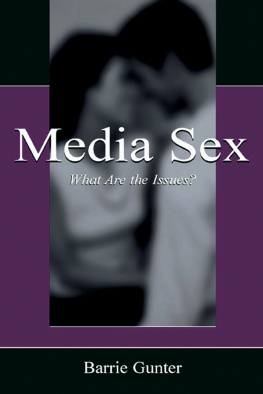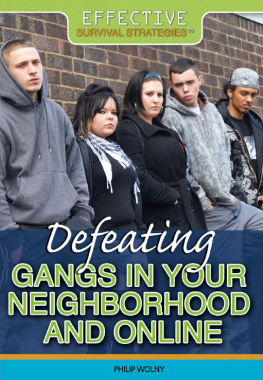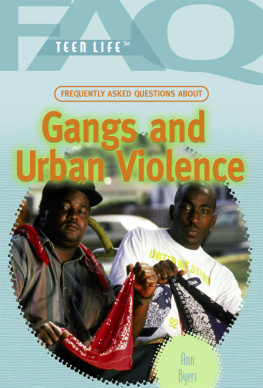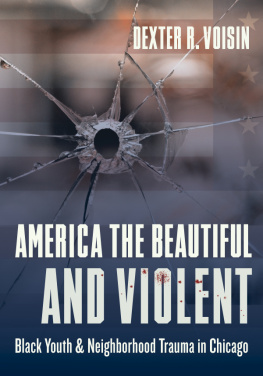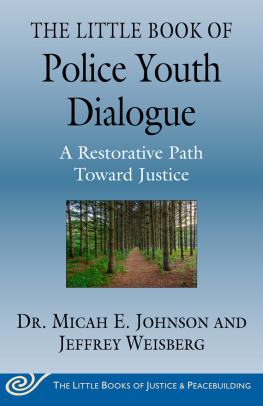RACE, GANGS AND YOUTH VIOLENCE
Policy, prevention and policing
Anthony Gunter
First published in Great Britain in 2017 by
Policy Press University of Bristol 1-9 Old Park Hill Bristol BS2 8BB UK Tel +44 (0)117 954 5940 e-mail
North American office: Policy Press c/o The University of Chicago Press 1427 East 60th Street Chicago, IL 60637, USA t: +1 773 702 7700 f: +1 773-702-9756 e:
Policy Press 2017
British Library Cataloguing in Publication Data
A catalogue record for this book is available from the British Library.
Library of Congress Cataloging-in-Publication Data
A catalog record for this book has been requested.
ISBN 978-1-4473-2287-0 paperback
ISBN 978-1-4473-2289-4 ePub
ISBN 978-1-4473-2290-0 Kindle
ISBN 978-1-4473-2288-7 ePdf
The right of Anthony Gunter to be identified as author of this work has been asserted by him in accordance with the 1988 Copyright, Designs and Patents Act.
All rights reserved: no part of this publication may be reproduced, stored in a retrieval system, or transmitted in any form or by any means, electronic, mechanical, photocopying, recording, or otherwise without the prior permission of Policy Press.
The statements and opinions contained within this publication are solely those of the author and not of The University of Bristol or Policy Press. The University of Bristol and Policy Press disclaim responsibility for any injury to persons or property resulting from any material published in this publication.
Policy Press works to counter discrimination on grounds of gender, race, disability, age and sexuality.
Cover design by Policy Press
Front cover: image kindly supplied by istock
Readers Guide
This book has been optimised for PDA.
Tables may have been presented to accommodate this devices limitations.
Image presentation is limited by this devices limitations.
Acknowledgements
This book has been many years in the making and has been informed by hundreds (perhaps thousands) of hours worth of conversations, observations and experiences, initially as a community and youth work practitioner and more recently as an ethnographer/academic. To this end I must first say thank you to all the young people I have worked with and/or who have featured in my research.
Thank you to Annetta Bennett and Charlie Parker for your wonderful insights over the years and for continuing to inspire me with your passionate commitment to the young people you work with.
Thanks and appreciation must also go to the British Academy for the funding that allowed me to carry out the research which I utilise in Chapters two, five and six. A big thank you as well goes out to Sara Krishnan and Hanif Barker who were the RAs on this project.
Many thanks to Clare Choak for the girls and gangs discussions and for always making sure I am up to date with all the latest articles and publications. I also have to acknowledge the massive intellectual debt that I owe to Ian Joseph as without doubt my ideas and opinions on what I unapologetically refer to as gang w**k, have been greatly shaped by our many hours of arguments (over one too many beers) and of course our 2011 Runnymede Trust publication Whats a Gang and Whats Race Got to Do with It?. A thank you also goes to Victoria Pittman (for supporting this book project from the outset) and the editorial and production team at Policy Press.
Lastly, I must express my love and gratitude to Heather (in addition to your proof reading duties), Mali and Aiyana for your encouragement, support and most of all endurance.
Glossary
Badness: refers to a social world characterised by spectacular hyper-aggressive/hyper- masculine modes of behaviour, usually centring around violent/petty crime and low-level drug dealing.
Back up: where a young person can call on the physical support of friends, neighbourhood peers or family members where there is/has been a threat of violence.
Beats: instrumental music tracks produced by young people themselves or taken from an already existing piece of recorded music.
Beef: where a young person (or group of young people) has a dispute or argument with another young person or group.
Bowling: a slow rhythmic and confident style of walking adopted by young males.
Bring it or Move to: where a group of young men violently assault a smaller group of young men (or an individual).
Bus Joke or Catching joke: where young people relay humorous stories and situations back to each other, talk about girls or boys and generally diss (name calling/mickey taking) each other.
Chiefed off: where a young person feels slighted and disrespected, or taken for an idiot as someone who is simple/weak and can therefore be taken advantage of by others.
Fam: short for family, a term for a close knit group of friends usually from the same neighbourhood or estate.
Garms: refers to clothes/dress wear.
Kicking ball: playing football.
Kotch or Chillin: is to sit down and relax/stay in one place as opposed to passing through.
Linking Yats: sexual liaisons between young men and young women more than just friends but less than girl/boyfriends. In this instance Yats refers to young women.
On the Endz: where a young person is referring to being in their own neighbourhood.
OTF: refers to the phrase only the fam (family); fam/family here relates to a close group of neighbourhood peers/friends.
Pass through: visiting a place but not intending to stay for very long.
On Road: the social and cultural worlds that the young people both create and inhabit, indicating where (on the streets and in other public spaces) and how they spend the majority of their leisure time.
Slippin: to be seen to have lost control of a situation or to come across as vulnerable/weak on Road.
Spitting or MCing: to rap song lyrics via use of rhythmic word flow and rhyming techniques.
Shank: to stab someone with a knife or other sharp weapon.
Swagger: confidence and style when kotching or moving about the neighbourhood.
Youngers: description of someone (or a group of individuals) younger in age.
Introduction
Every week there are numerous headlines, opinion pieces or reports on the pandemic of gang-related youth violence and crime throughout the myriad of local and national print and broadcast media outlets. Consequently, all reported incidents of youth violence involving either a knife or gun that occur within any of Englands poor multi-ethnic urban locations are automatically deemed to be caused by the menace of street gangs. This situation is further corroborated by police intelligence and statistics as well as by a small but growing number of criminological studies. Moreover, the existence and unique problem of street gangs has been officially recognised by national policy makers via the implementation of a range of new legislative tools and powers. In June 2015 the Conservative government both widened and extended the scope of gang injunctions which were first introduced under the New Labour administration and also introduced an updated statutory definition of gangs to be used across all of the police and public services including health, education, children and youth services. The official definition of UK street gangs was originally arrived upon by the Conservative-Liberal coalition in 2011 as part of its Ending Gang and Youth Violence (EGYV) strategy. However, the refreshed and more flexible 2015 definition allows the police and local authorities to take pre-emptive action in order for them to more effectively tackle gang and drug-related violent crime.


